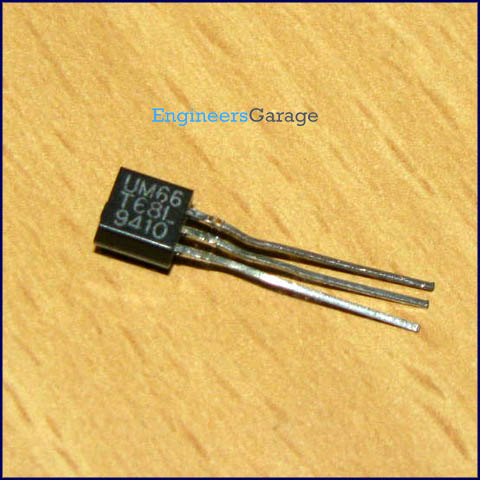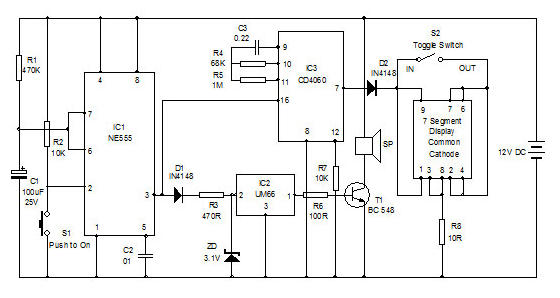Here is a simple Music Bell with In and Out indicator. The bell as well as the display turns on for 2 minutes and stop automatically. The circuit uses the popular ROM IC UM66 to generate music tone and a common cathode 7 segment display to show In or Out.

Fig. 1: Image of ROM IC UM66
IC1 (NE555) is wired as a short duration Monostable timer to activate the remaining circuits for a period of 2 minutes with the given values of R1 and C1. When the push switch S1 is pressed and released, the output of IC1 turns high and remains as such for 2 minutes. This high output is used to drive IC2 and IC3. IC2 is the ROM IC which oscillates when it gets 3 volts DCthrough the Zener regulated power supply.The feeble oscillations are amplified by T1which can be heard through the speaker loudly.
When IC1 gives high output, IC3 also gets power and it starts to oscillate. CD4060 is the14 stage ripple free binary counter which oscillates with the components C3 and R4. These oscillations are available from the outputs of IC3. Out of the 10 outputs, the first output is used to drive the seven segment display.
A common cathode seven segment display is used here. Its pins 3 and 8 are Cathode (ground) pins and the remaining pins are anode pins. Its anode pins are connected together to get “ I” for IN and “ O” for OUT. When the toggle switch (2 pin type) is in the Off position, only pins 1 and 9 gets power supply so that it displays I to indicate IN. When the toggle switch is in the ON position, pins 6,7 and 2,4 gets power along with 1and 9. This shows the O display to indicate OUT. Display blinks for 2 minutes and turns off along with the bell.
Use a small 8 ohms speaker. Power source can be a 9 volt PP3 battery or 9-12 volt power supply.
Circuit Diagrams
Filed Under: Electronic Projects



Questions related to this article?
👉Ask and discuss on EDAboard.com and Electro-Tech-Online.com forums.
Tell Us What You Think!!
You must be logged in to post a comment.